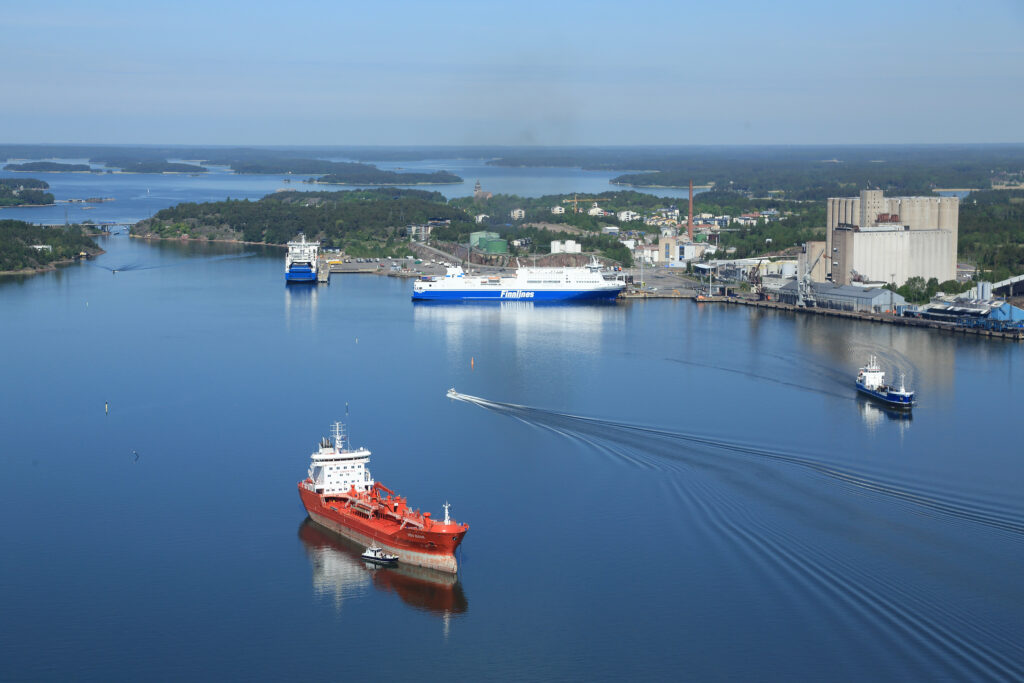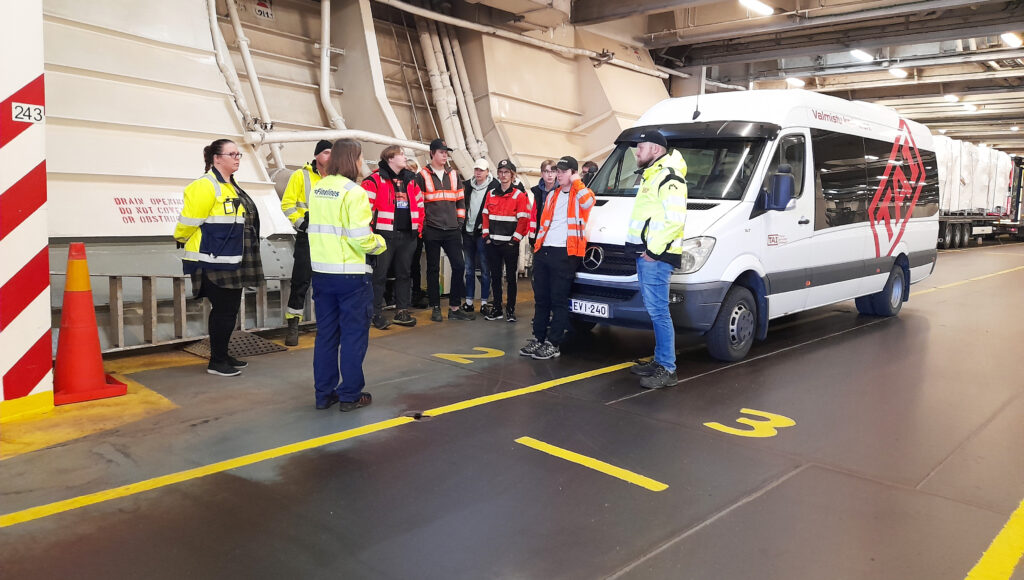Logistics students from Turku Vocational Institute familiarised themselves with the operations of Port Naantali and Finnlines

The safety aspect is emphasised in the shipping company’s daily activities, in good and close co-operation with the Port.
Based in the Port of Naantali, shipping company Finnlines is giving lectures in the port for logistics (professional driver) students from the Turku Vocational Institute. Visits and lectures targeted at professional drivers have been held in the Port of Naantali on an annual basis.
On the Port’s behalf, the lectures were given by Hannu Kallio, Operations Manager of the Port of Naantali, who gave a general presentation of the port from the logistical point of view.
The visit of the student group was part of the course of international transports and port operations in the Turku Vocational Institute, and it was tailored especially for the students of logistics (professional driver studies).
Finnlines’ presentation was given by Logistics Expert Pilvi Salonen who works at Cargo Customer Service. She introduced the shipping company’s operations and various instructions directed at the drivers. Furthermore, Pilvi told about an ongoing building project: Finnlines is currently building two Superstar ropax vessels which will start on the Naantali–Långnäs–Kapellskär route next year. Then the passenger capacity of Finnlines vessels will be doubled in the Port of Naantali to up to 1100 passengers/vessel. One vessel has room for around 200 passenger cars and 300 trucks, which brings its cargo capacity to a total of 5200 lane metres.
Finnlines is also known for being able to arrange oversized shipments (project and special transports of long goods) conveniently on this route.
Safety first
Unloading and loading of ships is done quickly in the Port of Naantali, the drivers operate independently in the field area. As the work of the drivers is independent, safety issues require special attention – at all times. Safety is an important part of daily operating in the entire port area.
The daily activities of Finnlines always emphasise safe and smooth work in the port, such as the Port of Naantali. The Port has built the functional and continuously developing infrastructure in the area and the gates, as well as having implemented clear driving and other lane instructions in the port area.
Pilvi stressed in her presentation that it is important for the driver to focus on driving in the field area and on board the ship, and pay special attention to where and how they will go next in the outdoor area. There are many machines moving about in the area in connection with loading, so you need to stay alert. That is also closely linked to prevention of accidents by always taking the safety aspects into account. For example, reflective clothing (reflective vest) must always be worn in the field area, the use of a telephone or similar devices is prohibited in the field area and in the ship while driving, and idling shall be avoided. The driver is always responsible for the goods and vehicle transported by them. At the end of the lecture, Pilvi reviewed briefly the company’s safety instructions.
Hannu Kallio (Operations Manager, Master of Science (Engineering)), gave a presentation on the Port of Naantali in which he introduced the different port areas (inner harbour Kantasatama, Luonnonmaa, and oil harbour), the companies operating in the area, typical types of transport occurring in Naantali (e.g. bulk goods, dangerous goods, tramp vessel service etc.), the Port’s ro-ro/ropax traffic, sustainable development solutions, and future transport chains. The Port of Naantali’s role regarding Finland’s imports and exports. Naantali plays an important role in e.g. the emergency supply services of the Åland islands.
”There are currently a number of big construction projects underway for enhancing the infrastructure in the Port of Naantali. We are switching to geothermal heating and will introduce partial geothermal cooling. A new automooring system for automated mooring and unmooring is being built in the port to make mooring of vessels faster and safer. The Port is building a shore-side electricity supply connection which will help to reduce local emissions considerably”, says Hannu Kallio, Operations Manager of the Port.
“Although the technology is developing and digitalisation is everywhere, robots will not take over the jobs of drivers; professional drivers will always be needed”, said Hannu Kallio, Operations Manager of the Port.
Students got to see a Star class ropax vessel Finnswan
Johanna Djupsjöbacka, Chief Officer at Finnlines, presented operations of Finnlines to the group on board the ship.
Chief Officer prepares the cargo plans for a departure, monitors loading and unloading, and participates in the navigation of the ship. There are a total of four people working as chief officers on Finnlines vessels on the Naantali–Kapellskär route, in two-week shifts.

Johanna Djupsjöbacka, Chief Officer at Finnlines, presented operations of Finnlines to the group on board the ship.
During the visit the group learned about the different cargo decks of the ship and were told what you need to take into account during loading and unloading. Basic issues include among other things electricity connection (e.g. thermal shipments) during the voyage or possible shipments of dangerous goods. Oversized transports require special attention during loading. Turning radius and other structural qualities of different vehicle types are always checked together with the loading staff.
Transport industry needs new drivers
The transport industry is suffering from a short supply of drivers. “The transport industry is hoping to attract new drivers who will boldly take foreign shipments in addition to driving in Finland”, says Sari Vilen, Customer Service Manager at Finnlines.
Text: Tarja Siekkinen
